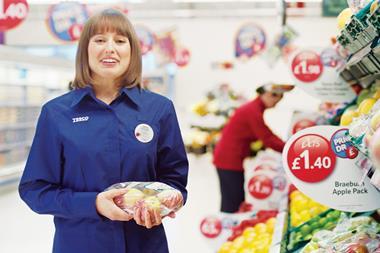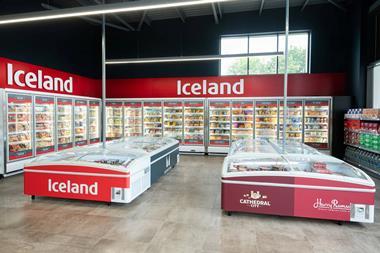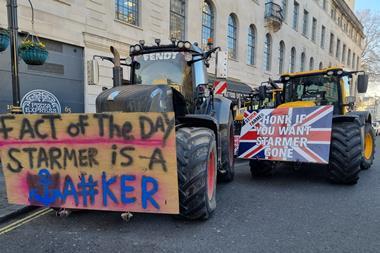Tesco may appear to dominate the grocery landscape, but research shows pockets of opportunity, says Liz Hamson
And it’s not just the big four that are are showing their mettle. Somerfield has managed to get its name on the map for the first time since the survey started, assuming dominance in three areas as a result of its acquisition of stores from Morrisons. In fact, Waitrose, Lidl and the Co-ops can all be found beating the big four in certain areas.
Tesco looks infallible with its market share of more than 30%. But although it dominates the landscape on a national level, there are still regional areas that it does not control or controls only marginally. These are the opportunities its rivals should be looking to exploit if they want to take the fight to the UK’s number one, suggests the latest annual demographic survey carried out by location planning and market analysis company CACI.
Growth Opportunities for Grocery uses CACI’s catchment model, ProVision, to show the grocery battles Tesco is winning - and losing - across the country.
On the face of it, Tesco appears to be totally dominant. Of 120 postal districts, it controls 67, while Asda has 23, Sainsbury 14 and Morrisons 13 - actually fewer than last year despite the acquisition of Safeway.
As the second map, which highlights the second most dominant players, shows, even where Tesco is not in control, it typically has the second highest market share.
However, the outlook is not quite as bleak for rivals as it seems. For one, Tesco does not always have a commanding lead in the areas it controls. Sometimes its market share is just a couple of percent higher than its nearest rival. Also, closer analysis of the data reveals clear pockets of resistance - many in strategically important areas. Sainsbury, for instance, continues to hold on to key areas in the south east, some of the largest and wealthiest catchments in the country. Asda’s power base, meanwhile, is spreading beyond its northern heartland into areas such as Swindon, Nottingham and the Midlands as it takes the fight to Tesco on a national level.
As a result, there are a significant number of areas where Tesco isn’t doing so well and in some instances is even relegated to third place or lower. In both Wolverhampton and Kirkwall, for example, it lies in fourth position, in Sunderland it’s in sixth, and in Harrogate seventh.
As the main map shows, there are also a number of big areas where the top four each have similar market shares. Basingstoke, Edinburgh, Huddersfield, Stockport and Weston-super-Mare are key battlegrounds.
While there are very few areas in the country that could be truly described as grocery deserts, and Tesco has shown an unerring knack for getting in there first if it does scent an opportunity, it does not always read the landscape right, adds CACI senior analyst Carl Bradbrook.
Take its controversial scheme under development at Gerrards Cross. The study estimates that there is a total of £260m of expenditure available in the area, of which only £49m is not going to the top four. Bradbrook argues that the 20,000 sq ft store is too big to justify given the potential spend available, adding that the local demographics are more closely aligned with Waitrose than Tesco shoppers.
“For Tesco to be a success, it will need to attract a large amount of expenditure from Sainsbury, Asda and Morrisons,” he says. “This will be a big challenge and raises the question as to why Tesco is persisting with its attempts to build a store in this location.”
Elsewhere, the survey suggests that Tesco - and indeed Asda, Sainsbury and Morrisons - will continue to compete fiercely for market share at the expense of the independents.
“As each of the big four attempts to increase its local share, the slice of expenditure going to the smaller retailers will be reduced,” says Bradbrook.
The only areas in which the independents continue to hold their own are urban areas such as Paddington, in London, where a sizeable 60% of grocery expenditure is going to supermarkets other than the big four. Sainsbury has acquired land on the edge of this area, probably on this very basis.
But, although there is potentially market share up for grabs, developing a store here would be unwise given the sheer number of convenience stores in the area, suggests Bradbrook. “There would be a high level of risk in proceeding with this store. It could result in the store underperforming against expectations,” he says.
In other words, if an area looks like a sure bet, there’s probably a catch. Indeed, admits Bradbrook of the number of battlegrounds: “I would have expected to see them throughout the country, not just in five areas.”
With untapped opportunities few and far between, increasingly it will take analysis of demographics at a local level to ascertain whether the numbers stack up or not.
Catchment study: category potential
The catchment model can also be used to determine the areas and even the stores in the country that offer the best potential for a particular product or category.
Take fish fingers. The geodemographic classification system ACORN profile study shows that it is mainly families and blue collar workers who buy fish fingers. Overlaying this with CACI’s study, the bars tally most closely at Somerfield in Prescot, Lancashire, making it the supermarket with the strongest potential demand for fish fingers in the country.
Conversely, the high concentration of educated urbanites in Brighton means that Somerfield’s Brighton store is in one of the areas with the weakest demand.
As far as the top four go, the best and worst areas are:
Best catchments
Asda: Widnes
Sainsbury: Wakefield
Morrisons: Ellesmere Port
Tesco: Stockton-on-Tees
worst catchments
Asda: Edinburgh
Sainsbury: Islington
Morrisons: Wood Green
Tesco: South Tottenham
Tesco’s top towns
1Inverness51.21%
2Milton Keynes49.69%
3Twickenham47.23%
4Uxbridge46.97%
5Hemel Hempstead45.52%
Gerrards Cross
Tesco is still pushing ahead with its controversial development of a 20,000 sq ft scheme at Gerrards
And it’s not just the big four that are are showing their mettle. Somerfield has managed to get its name on the map for the first time since the survey started, assuming dominance in three areas as a result of its acquisition of stores from Morrisons. In fact, Waitrose, Lidl and the Co-ops can all be found beating the big four in certain areas.
Tesco looks infallible with its market share of more than 30%. But although it dominates the landscape on a national level, there are still regional areas that it does not control or controls only marginally. These are the opportunities its rivals should be looking to exploit if they want to take the fight to the UK’s number one, suggests the latest annual demographic survey carried out by location planning and market analysis company CACI.
Growth Opportunities for Grocery uses CACI’s catchment model, ProVision, to show the grocery battles Tesco is winning - and losing - across the country.
On the face of it, Tesco appears to be totally dominant. Of 120 postal districts, it controls 67, while Asda has 23, Sainsbury 14 and Morrisons 13 - actually fewer than last year despite the acquisition of Safeway.
As the second map, which highlights the second most dominant players, shows, even where Tesco is not in control, it typically has the second highest market share.
However, the outlook is not quite as bleak for rivals as it seems. For one, Tesco does not always have a commanding lead in the areas it controls. Sometimes its market share is just a couple of percent higher than its nearest rival. Also, closer analysis of the data reveals clear pockets of resistance - many in strategically important areas. Sainsbury, for instance, continues to hold on to key areas in the south east, some of the largest and wealthiest catchments in the country. Asda’s power base, meanwhile, is spreading beyond its northern heartland into areas such as Swindon, Nottingham and the Midlands as it takes the fight to Tesco on a national level.
As a result, there are a significant number of areas where Tesco isn’t doing so well and in some instances is even relegated to third place or lower. In both Wolverhampton and Kirkwall, for example, it lies in fourth position, in Sunderland it’s in sixth, and in Harrogate seventh.
As the main map shows, there are also a number of big areas where the top four each have similar market shares. Basingstoke, Edinburgh, Huddersfield, Stockport and Weston-super-Mare are key battlegrounds.
While there are very few areas in the country that could be truly described as grocery deserts, and Tesco has shown an unerring knack for getting in there first if it does scent an opportunity, it does not always read the landscape right, adds CACI senior analyst Carl Bradbrook.
Take its controversial scheme under development at Gerrards Cross. The study estimates that there is a total of £260m of expenditure available in the area, of which only £49m is not going to the top four. Bradbrook argues that the 20,000 sq ft store is too big to justify given the potential spend available, adding that the local demographics are more closely aligned with Waitrose than Tesco shoppers.
“For Tesco to be a success, it will need to attract a large amount of expenditure from Sainsbury, Asda and Morrisons,” he says. “This will be a big challenge and raises the question as to why Tesco is persisting with its attempts to build a store in this location.”
Elsewhere, the survey suggests that Tesco - and indeed Asda, Sainsbury and Morrisons - will continue to compete fiercely for market share at the expense of the independents.
“As each of the big four attempts to increase its local share, the slice of expenditure going to the smaller retailers will be reduced,” says Bradbrook.
The only areas in which the independents continue to hold their own are urban areas such as Paddington, in London, where a sizeable 60% of grocery expenditure is going to supermarkets other than the big four. Sainsbury has acquired land on the edge of this area, probably on this very basis.
But, although there is potentially market share up for grabs, developing a store here would be unwise given the sheer number of convenience stores in the area, suggests Bradbrook. “There would be a high level of risk in proceeding with this store. It could result in the store underperforming against expectations,” he says.
In other words, if an area looks like a sure bet, there’s probably a catch. Indeed, admits Bradbrook of the number of battlegrounds: “I would have expected to see them throughout the country, not just in five areas.”
With untapped opportunities few and far between, increasingly it will take analysis of demographics at a local level to ascertain whether the numbers stack up or not.
Catchment study: category potential
The catchment model can also be used to determine the areas and even the stores in the country that offer the best potential for a particular product or category.
Take fish fingers. The geodemographic classification system ACORN profile study shows that it is mainly families and blue collar workers who buy fish fingers. Overlaying this with CACI’s study, the bars tally most closely at Somerfield in Prescot, Lancashire, making it the supermarket with the strongest potential demand for fish fingers in the country.
Conversely, the high concentration of educated urbanites in Brighton means that Somerfield’s Brighton store is in one of the areas with the weakest demand.
As far as the top four go, the best and worst areas are:
Best catchments
Asda: Widnes
Sainsbury: Wakefield
Morrisons: Ellesmere Port
Tesco: Stockton-on-Tees
worst catchments
Asda: Edinburgh
Sainsbury: Islington
Morrisons: Wood Green
Tesco: South Tottenham
Tesco’s top towns
1Inverness51.21%
2Milton Keynes49.69%
3Twickenham47.23%
4Uxbridge46.97%
5Hemel Hempstead45.52%
Gerrards Cross
Tesco is still pushing ahead with its controversial development of a 20,000 sq ft scheme at Gerrards



















No comments yet